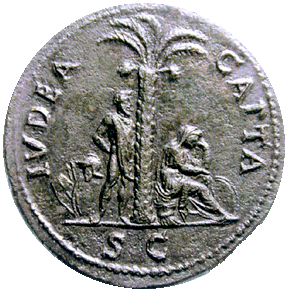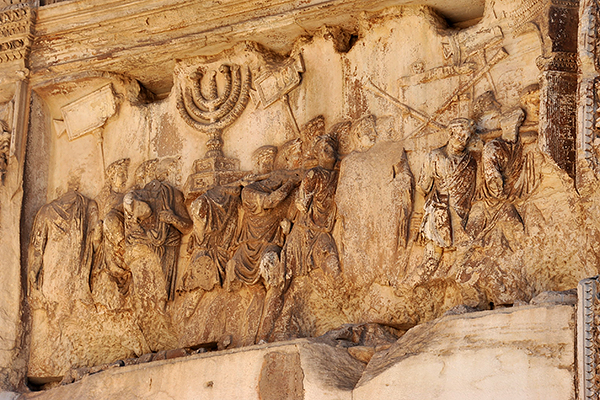"But for those that were taken in the temple of Jerusalem, they made the greatest figure of them all; that is, the golden table, of the weight of many talents; the candlestick also, that was made of gold, though its construction were now changed from that which we made use of; for its middle shaft was fixed upon a basis, and the small branches were produced out of it to a great length, having the likeness of a trident in their position, and had every one a socket made of brass for a lamp at the tops of them. These lamps were in number seven, and represented the dignity of the number seven among the Jews; and the last of all the spoils, was carried the Law of the Jews [although the Torah is not represented on the arch]."
Josephus, Jewish War (VII.5.5)
The Second Temple of Jerusalem was sacked by Titus in AD 70 and its treasures, after being triumphantly paraded through Rome, placed in the Temple of Peace. There they remained until Rome, itself, was sacked in AD 455 by Genseric (Gaiseric) the Vandal, who "placing an exceedingly great amount of gold and other imperial treasure in his ships sailed to Carthage, having spared neither bronze nor anything else whatsoever in the palace [including the gilded bronze roof tiles from the Temple of Jupiter Capitolinus]....and among these were the treasures of the Jews" (Procopius, The Vandalic War, III.5.3, IV.9.5).
Theophanes also relates the events of that year. Petronius Maximus, a patrician and senator murdered the emperor Valentinian III, who had had an affair with his wife, and forcibly married the empress Eudoxia, who wrote, in turn, to Genseric, exhorting him to come to Rome and avenge her. Two months later, Maximus himself was dead. Genseric sacked Rome. "Taking all the money and adornments of the city, he loaded them on his ships, among them the solid gold and bejewelled treasures of the Church and the Jewish vessels which Vespasian's son Titus had brought to Rome after the capture of Jerusalem. Having taken the empress Eudoxia and her daughters, he sailed back to Africa."
The Vandals were Arians, who believed that Jesus was not consubstantial with God the Father. Their fearful persecution of the Catholics of North Africa (as related by Victor Vitensis) prompted Justinian to dispatch his general Belisarius to defend against the heretic. Gelimer was defeated at the Battle of Tricamarum late in AD 533. Among the booty sent to Constantinople "were the treasures of the Jews, which Titus, the son of Vespasian, together with certain others, had brought to Rome, after the capture of Jerusalem" (IV.9.6). But, relates Procopius, Justinian returned them to the Christians of Jerusalem, having been admonished that Rome and then Carthage had been lost because of these relics, for "it is not possible for them to be elsewhere than in the place where Solomon, the king of the Jews, formerly placed them" (IV.9.9).
In AD 614, Jerusalem was captured by the Persians, who, records Antiochus Strategos, slaughtered its Christian inhabitants and sacked the city, taking away the True Cross (which was returned in AD 630). Their Jewish allies then "began with their own hands to demolish and burn such of the holy churches as were left standing."
Nothing more is recorded of the sacred objects of the Second Temple of Jerusalem.
 "Thy men shall fall by the sword, and thy mighty in the war. And her gates shall lament and mourn; and she being desolate shall site upon the ground." Isaiah III.25-26 |
IVDEA CAPTA [Judea Captured], SC in exergue. One of a series of commemorative coins, the reverse of this
bronze sestertius
shows a Jewish female (personifying Judaea) seated right in an attitude of mourning at
the base of palm tree, with
a captive male standing right, hands bound behind his back, and weapons, shields,
and helmets to the left, RIC 424 (Rome, AD 71).
The Judaea Capta series extended for twenty-five years through the reigns of Vespasian and his sons Titus and Domitian, and was issued in bronze, silver, and gold. Other coins in the series struck by Vespasian, of which the silver denarius was the most popular, depict Judaea seated at the feet of the victorious emperor, standing next to a palm tree with her hands bound, sitting alone next to a palm tree or Roman victory monument, or as a diminutive figure beneath a personification of Victory. |
The Ark of the Covenant had been lost centuries earlier. Returned to Jerusalem by King David (II Samuel 6:2ff), it was placed in the First Temple by his son Solomon (I Kings 6:19, 8:1ff) and probably was among "the treasures of the house of the Lord" (I Kings 14:25-26) looted by Shishak, the king of Egypt, about 925 BC. It is not mentioned among the sacred vessels of gold, silver, and brass taken to Babylon in 587/586 BC by Nebuchadnezzar, who desolated Jerusalem and "burnt the house of the Lord" (II Kings 25:8-9ff; II Chronicles 36:18-19; Jeremiah 52:17-23).
Antiochus IV (Epiphanes), the king of Syria, had captured Jerusalem in 167 BC and desecrated the Temple by offering the sacrifice of a pig on an altar to Zeus (the Abomination of Desolation). In seeking to prohibit Judaism and Hellenize the Jews, Antiochus forbade their religious practices and commanded that copies of the Law be burned, all of which is related by Josephus in the Antiquities of the Jews.
"So he left the temple bare, and took away the golden candlesticks, and the golden altar [of incense], and table [of shew-bread], and the altar [of burnt-offering]; and did not abstain from even the veils, which were made of fine linen and scarlet. He also emptied it of its secret treasures, and left nothing at all remaining; and by this means cast the Jews into great lamentation..." (XII.5.4).
The Book of I Maccabees describes the revolt against Antiochus, who "arrogantly entered the sanctuary and took the golden altar, the lampstand for the light, and all its utensils. He took also the table for the bread of the Presence, the cups for drink offerings, the bowls, the golden censers, the curtain, the crowns, and the gold decoration on the front of the temple; he stripped it all off. He took the silver and the gold, and the costly vessels; he took also the hidden treasures which he found. Taking them all, he departed to his own land" (1:21-24; also II Maccabees 5:16). Three years later, Jerusalem was recaptured by Judah Maccabee and the Temple reconsecrated, "They made new holy vessels, and brought the lampstand, the altar of incense, and the table into the temple. Then they burned incense on the altar and lighted the lamps on the lampstand, and these gave light in the temple. They placed the bread on the table and hung up the curtains. Thus they finished all the work they had undertaken" (IV.49-51; also Antiquities of the Jews, XII.7.6).
In 63 BC, Pompey desecrated the Holy of Holies when he entered the sanctuary. There he "saw what was reposited therein, the candlestick with its lamps, and the table, and the pouring vessels, and the censers, all made entirely of gold, as also a great quantity of spices heaped together, with two thousand talents of sacred money. Yet did not he touch that money, nor any thing else that was there reposited; but he commanded the ministers about the temple, the very next day after he had taken it, to cleanse it, and to perform their accustomed sacrifices" (Josephus, Jewish War, I.7.6; also Antiquities of the Jews, XIV.4.4). Crassus, on his way to Parthia, where he would die, was not so respectful and plundered the Temple of all its gold, worth eight thousand talents, as well as two thousand talents in coin (Antiquities of the Jews, XIV.7.1).
The relief above is from the passage of the Arch of Titus and shows, in addition to the Menorah and Table of the Showbread, the ritual trumpets. Presumably, the candelabrum and Table are those created in 164 BC and seen by Pompey a hundred years later. Unlike the other two ritual objects which God on Mt. Sinai commanded be made (Exodus 25:23-40), the silver trumpets must have looked much as they did originally. "And the Lord spake unto Moses, saying, Make thee two trumpets of silver; of a whole piece shalt thou make them: that thou mayest use them for the calling of the assembly, and for the journeying of the camps" (Numbers 10:1-2).
References: Procopius: History of the Wars [The Vandalic War] (1953) translated by H. B. Dewing (Loeb Classical Library); "Antiochus Strategos' Account of the Sack of Jerusalem in A.D. 614" (1910) translated by Frederick C. Conybeare, The English Historical Review, 25(99), 502-517; The Works of Flavius Josephus (1737) translated by William Whiston; The Chronicle of Theophanes Confessor (1997) translated by Cyril Mango and Roger Scott; "Antiochus Strategos, The Capture of Jerusalem by the Persians in 614 AD" (1910) by Frederick C. Conybeare, English Historical Review, 25(99), 502-517; Victor of Vita: History of the Vandal Persecution (1992) translated by John Moorhead; God's Gold: A Quest for the Lost Temple Treasures of Jerusalem (2007) by Sean Kingsley, who spins an entire (and rather vapid and sometimes erroneous) book out of these brief accounts. The coin is from Freeman & Sear, Fixed Price List 10 (Spring 2005), Item 91.
